Managerial Accounting: CVP, Working Capital, Stock Value, & Budgeting
VerifiedAdded on 2023/04/07
|34
|7808
|254
Report
AI Summary
This report provides a detailed analysis of several key concepts in managerial accounting. It begins with a discussion of the usefulness of cost-volume-profit (CVP) analysis, highlighting its benefits in evaluating the impact of changes in cost and volume on a company's operating income. The report then explores various policy options for working capital management, differentiating between short-term and long-term strategies, including hedging policies and their implications. Furthermore, it addresses the statement that managers should not overemphasize current stock value at the expense of long-term profits, examining the potential pitfalls of such a focus. The purpose of internal controls for budgeting is also discussed, emphasizing their role in ensuring financial accuracy and accountability. Finally, the report illustrates the break-even point and analyzes its usefulness, while also acknowledging the limitations of break-even charts. The document uses examples, charts, and calculations to explain these concepts.
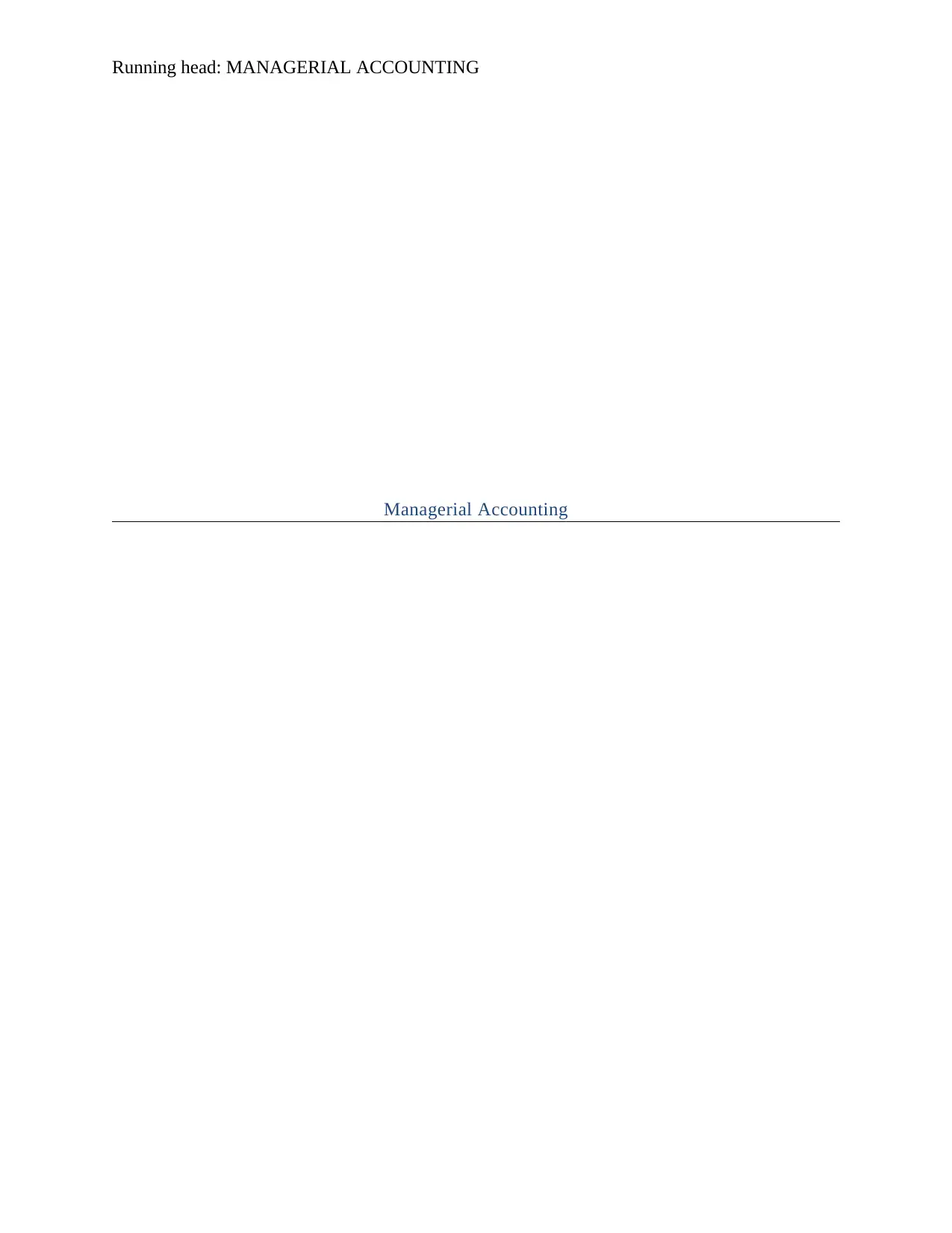
Running head: MANAGERIAL ACCOUNTING
Managerial Accounting
Managerial Accounting
Paraphrase This Document
Need a fresh take? Get an instant paraphrase of this document with our AI Paraphraser
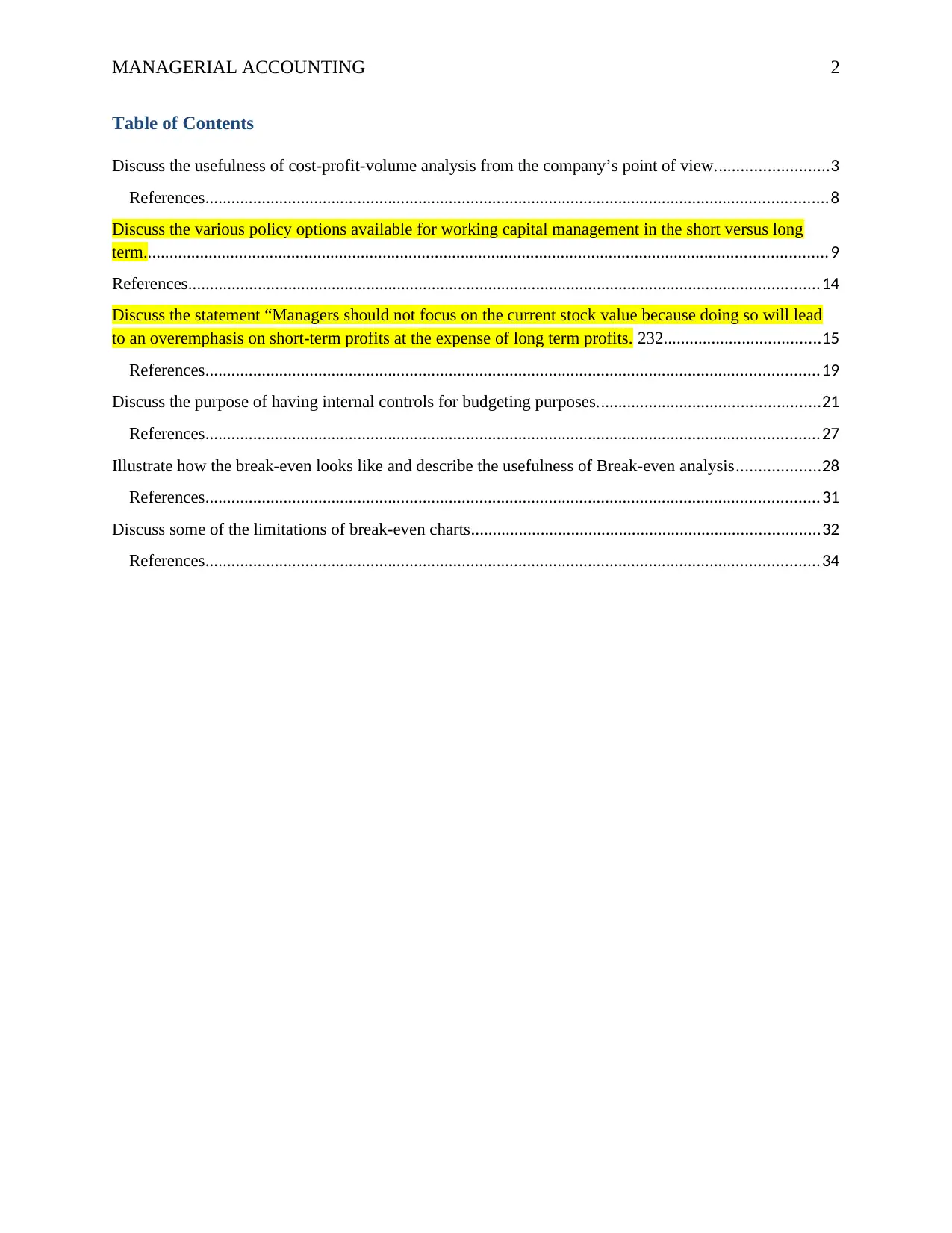
MANAGERIAL ACCOUNTING 2
Table of Contents
Discuss the usefulness of cost-profit-volume analysis from the company’s point of view..........................3
References...............................................................................................................................................8
Discuss the various policy options available for working capital management in the short versus long
term.............................................................................................................................................................9
References.................................................................................................................................................14
Discuss the statement “Managers should not focus on the current stock value because doing so will lead
to an overemphasis on short-term profits at the expense of long term profits. 232....................................15
References.............................................................................................................................................19
Discuss the purpose of having internal controls for budgeting purposes...................................................21
References.............................................................................................................................................27
Illustrate how the break-even looks like and describe the usefulness of Break-even analysis...................28
References.............................................................................................................................................31
Discuss some of the limitations of break-even charts................................................................................32
References.............................................................................................................................................34
Table of Contents
Discuss the usefulness of cost-profit-volume analysis from the company’s point of view..........................3
References...............................................................................................................................................8
Discuss the various policy options available for working capital management in the short versus long
term.............................................................................................................................................................9
References.................................................................................................................................................14
Discuss the statement “Managers should not focus on the current stock value because doing so will lead
to an overemphasis on short-term profits at the expense of long term profits. 232....................................15
References.............................................................................................................................................19
Discuss the purpose of having internal controls for budgeting purposes...................................................21
References.............................................................................................................................................27
Illustrate how the break-even looks like and describe the usefulness of Break-even analysis...................28
References.............................................................................................................................................31
Discuss some of the limitations of break-even charts................................................................................32
References.............................................................................................................................................34
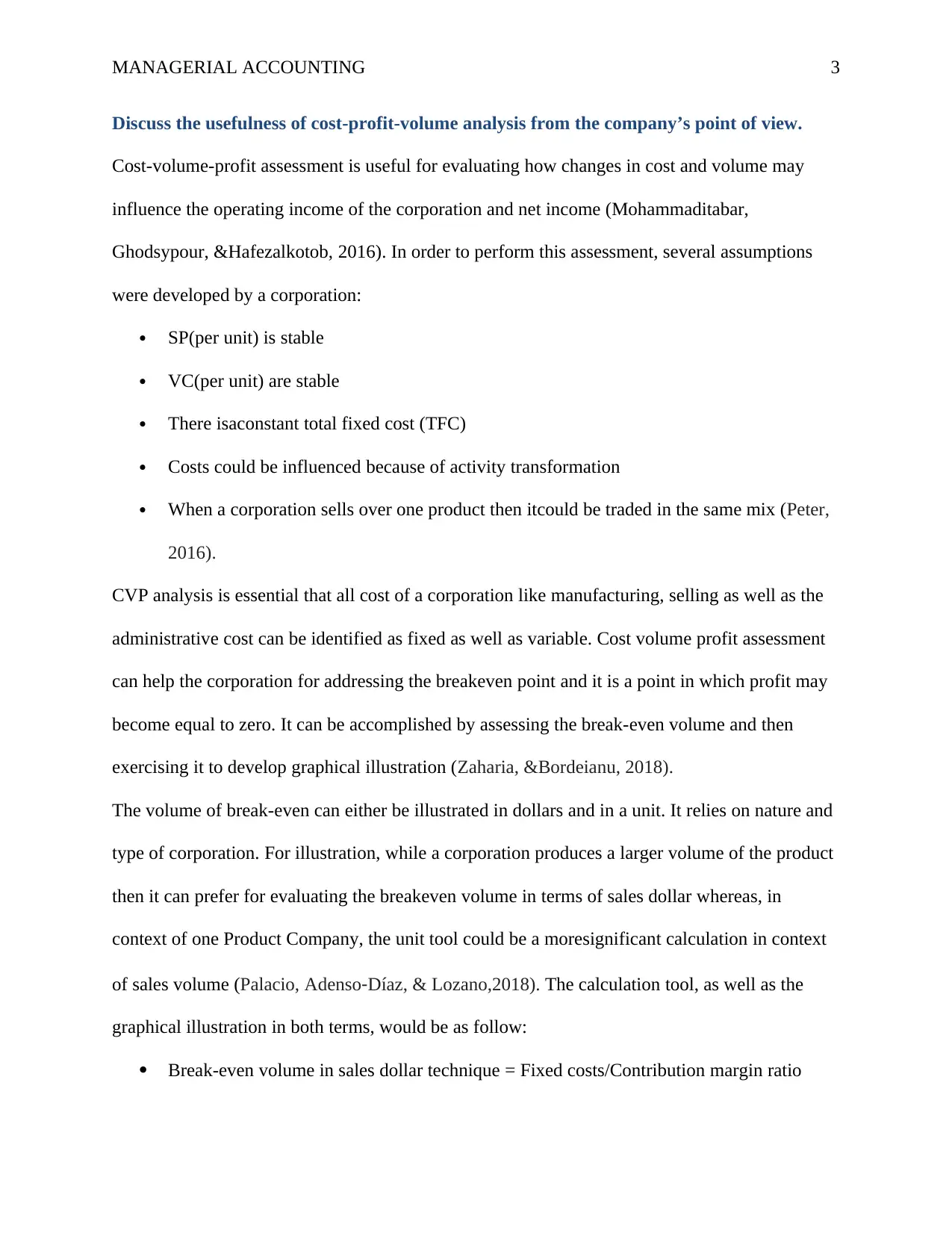
MANAGERIAL ACCOUNTING 3
Discuss the usefulness of cost-profit-volume analysis from the company’s point of view.
Cost-volume-profit assessment is useful for evaluating how changes in cost and volume may
influence the operating income of the corporation and net income (Mohammaditabar,
Ghodsypour, &Hafezalkotob, 2016). In order to perform this assessment, several assumptions
were developed by a corporation:
SP(per unit) is stable
VC(per unit) are stable
There isaconstant total fixed cost (TFC)
Costs could be influenced because of activity transformation
When a corporation sells over one product then itcould be traded in the same mix (Peter,
2016).
CVP analysis is essential that all cost of a corporation like manufacturing, selling as well as the
administrative cost can be identified as fixed as well as variable. Cost volume profit assessment
can help the corporation for addressing the breakeven point and it is a point in which profit may
become equal to zero. It can be accomplished by assessing the break-even volume and then
exercising it to develop graphical illustration (Zaharia, &Bordeianu, 2018).
The volume of break-even can either be illustrated in dollars and in a unit. It relies on nature and
type of corporation. For illustration, while a corporation produces a larger volume of the product
then it can prefer for evaluating the breakeven volume in terms of sales dollar whereas, in
context of one Product Company, the unit tool could be a moresignificant calculation in context
of sales volume (Palacio, Adenso‐Díaz, & Lozano,2018). The calculation tool, as well as the
graphical illustration in both terms, would be as follow:
Break-even volume in sales dollar technique = Fixed costs/Contribution margin ratio
Discuss the usefulness of cost-profit-volume analysis from the company’s point of view.
Cost-volume-profit assessment is useful for evaluating how changes in cost and volume may
influence the operating income of the corporation and net income (Mohammaditabar,
Ghodsypour, &Hafezalkotob, 2016). In order to perform this assessment, several assumptions
were developed by a corporation:
SP(per unit) is stable
VC(per unit) are stable
There isaconstant total fixed cost (TFC)
Costs could be influenced because of activity transformation
When a corporation sells over one product then itcould be traded in the same mix (Peter,
2016).
CVP analysis is essential that all cost of a corporation like manufacturing, selling as well as the
administrative cost can be identified as fixed as well as variable. Cost volume profit assessment
can help the corporation for addressing the breakeven point and it is a point in which profit may
become equal to zero. It can be accomplished by assessing the break-even volume and then
exercising it to develop graphical illustration (Zaharia, &Bordeianu, 2018).
The volume of break-even can either be illustrated in dollars and in a unit. It relies on nature and
type of corporation. For illustration, while a corporation produces a larger volume of the product
then it can prefer for evaluating the breakeven volume in terms of sales dollar whereas, in
context of one Product Company, the unit tool could be a moresignificant calculation in context
of sales volume (Palacio, Adenso‐Díaz, & Lozano,2018). The calculation tool, as well as the
graphical illustration in both terms, would be as follow:
Break-even volume in sales dollar technique = Fixed costs/Contribution margin ratio
⊘ This is a preview!⊘
Do you want full access?
Subscribe today to unlock all pages.

Trusted by 1+ million students worldwide
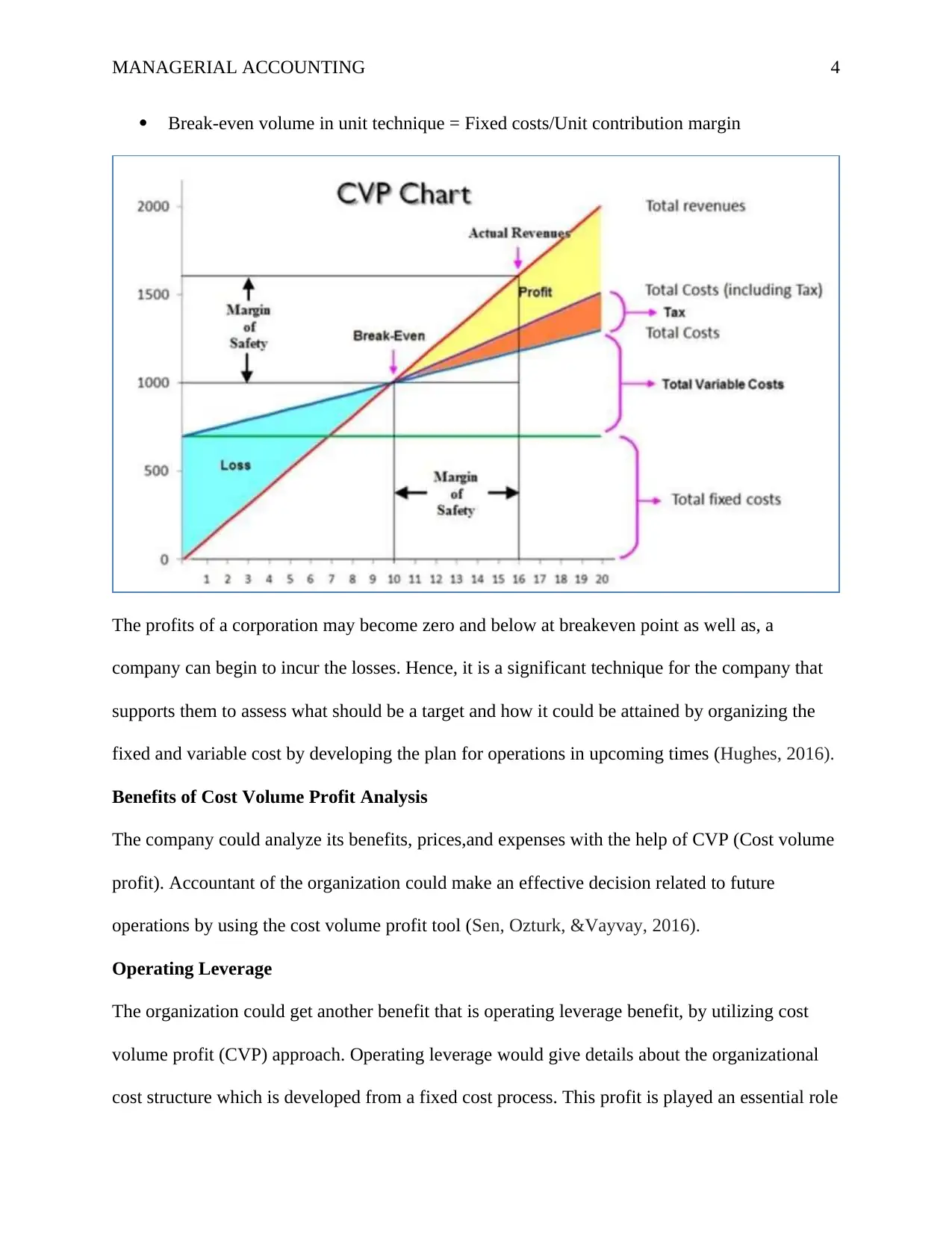
MANAGERIAL ACCOUNTING 4
Break-even volume in unit technique = Fixed costs/Unit contribution margin
The profits of a corporation may become zero and below at breakeven point as well as, a
company can begin to incur the losses. Hence, it is a significant technique for the company that
supports them to assess what should be a target and how it could be attained by organizing the
fixed and variable cost by developing the plan for operations in upcoming times (Hughes, 2016).
Benefits of Cost Volume Profit Analysis
The company could analyze its benefits, prices,and expenses with the help of CVP (Cost volume
profit). Accountant of the organization could make an effective decision related to future
operations by using the cost volume profit tool (Sen, Ozturk, &Vayvay, 2016).
Operating Leverage
The organization could get another benefit that is operating leverage benefit, by utilizing cost
volume profit (CVP) approach. Operating leverage would give details about the organizational
cost structure which is developed from a fixed cost process. This profit is played an essential role
Break-even volume in unit technique = Fixed costs/Unit contribution margin
The profits of a corporation may become zero and below at breakeven point as well as, a
company can begin to incur the losses. Hence, it is a significant technique for the company that
supports them to assess what should be a target and how it could be attained by organizing the
fixed and variable cost by developing the plan for operations in upcoming times (Hughes, 2016).
Benefits of Cost Volume Profit Analysis
The company could analyze its benefits, prices,and expenses with the help of CVP (Cost volume
profit). Accountant of the organization could make an effective decision related to future
operations by using the cost volume profit tool (Sen, Ozturk, &Vayvay, 2016).
Operating Leverage
The organization could get another benefit that is operating leverage benefit, by utilizing cost
volume profit (CVP) approach. Operating leverage would give details about the organizational
cost structure which is developed from a fixed cost process. This profit is played an essential role
Paraphrase This Document
Need a fresh take? Get an instant paraphrase of this document with our AI Paraphraser
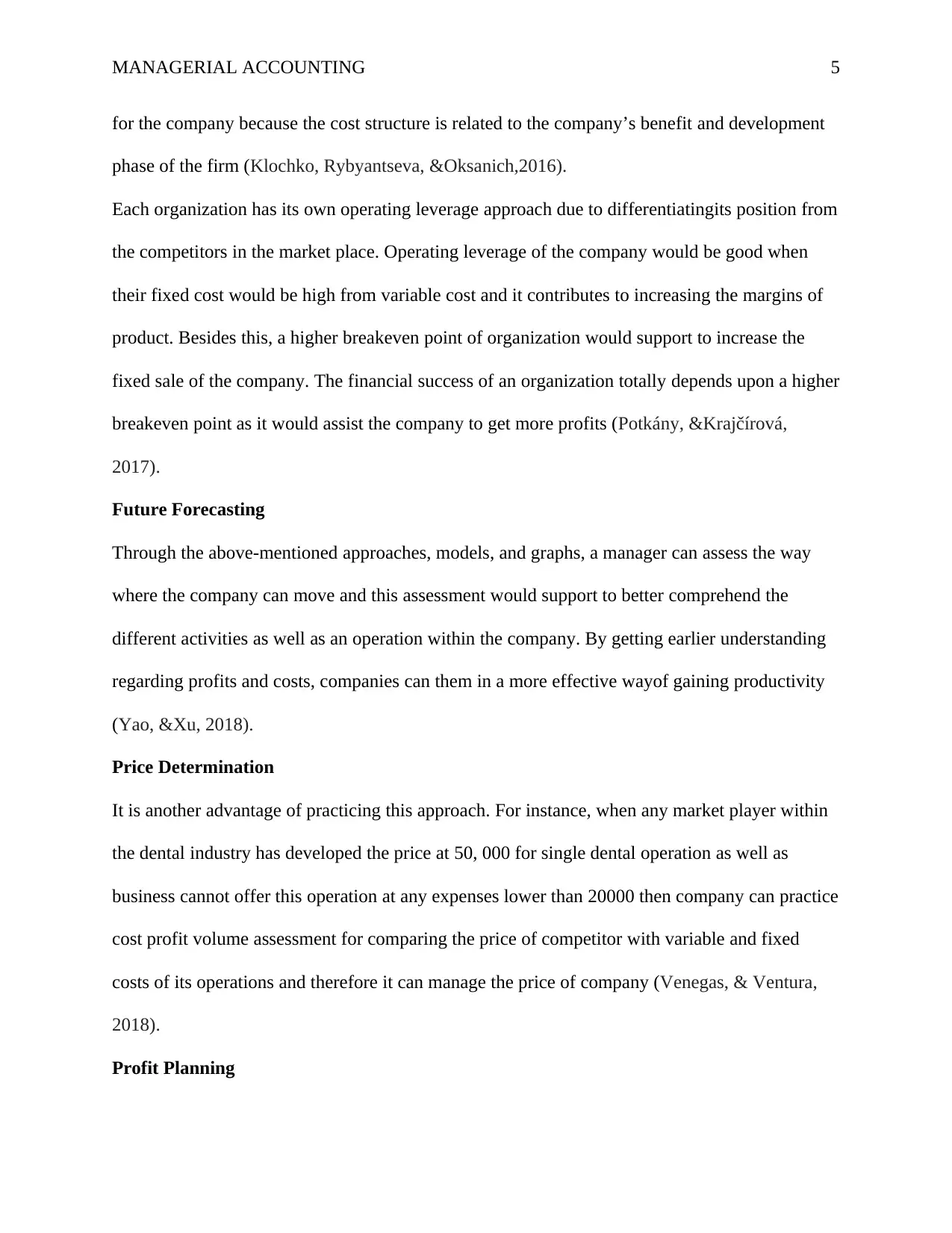
MANAGERIAL ACCOUNTING 5
for the company because the cost structure is related to the company’s benefit and development
phase of the firm (Klochko, Rybyantseva, &Oksanich,2016).
Each organization has its own operating leverage approach due to differentiatingits position from
the competitors in the market place. Operating leverage of the company would be good when
their fixed cost would be high from variable cost and it contributes to increasing the margins of
product. Besides this, a higher breakeven point of organization would support to increase the
fixed sale of the company. The financial success of an organization totally depends upon a higher
breakeven point as it would assist the company to get more profits (Potkány, &Krajčírová,
2017).
Future Forecasting
Through the above-mentioned approaches, models, and graphs, a manager can assess the way
where the company can move and this assessment would support to better comprehend the
different activities as well as an operation within the company. By getting earlier understanding
regarding profits and costs, companies can them in a more effective wayof gaining productivity
(Yao, &Xu, 2018).
Price Determination
It is another advantage of practicing this approach. For instance, when any market player within
the dental industry has developed the price at 50, 000 for single dental operation as well as
business cannot offer this operation at any expenses lower than 20000 then company can practice
cost profit volume assessment for comparing the price of competitor with variable and fixed
costs of its operations and therefore it can manage the price of company (Venegas, & Ventura,
2018).
Profit Planning
for the company because the cost structure is related to the company’s benefit and development
phase of the firm (Klochko, Rybyantseva, &Oksanich,2016).
Each organization has its own operating leverage approach due to differentiatingits position from
the competitors in the market place. Operating leverage of the company would be good when
their fixed cost would be high from variable cost and it contributes to increasing the margins of
product. Besides this, a higher breakeven point of organization would support to increase the
fixed sale of the company. The financial success of an organization totally depends upon a higher
breakeven point as it would assist the company to get more profits (Potkány, &Krajčírová,
2017).
Future Forecasting
Through the above-mentioned approaches, models, and graphs, a manager can assess the way
where the company can move and this assessment would support to better comprehend the
different activities as well as an operation within the company. By getting earlier understanding
regarding profits and costs, companies can them in a more effective wayof gaining productivity
(Yao, &Xu, 2018).
Price Determination
It is another advantage of practicing this approach. For instance, when any market player within
the dental industry has developed the price at 50, 000 for single dental operation as well as
business cannot offer this operation at any expenses lower than 20000 then company can practice
cost profit volume assessment for comparing the price of competitor with variable and fixed
costs of its operations and therefore it can manage the price of company (Venegas, & Ventura,
2018).
Profit Planning
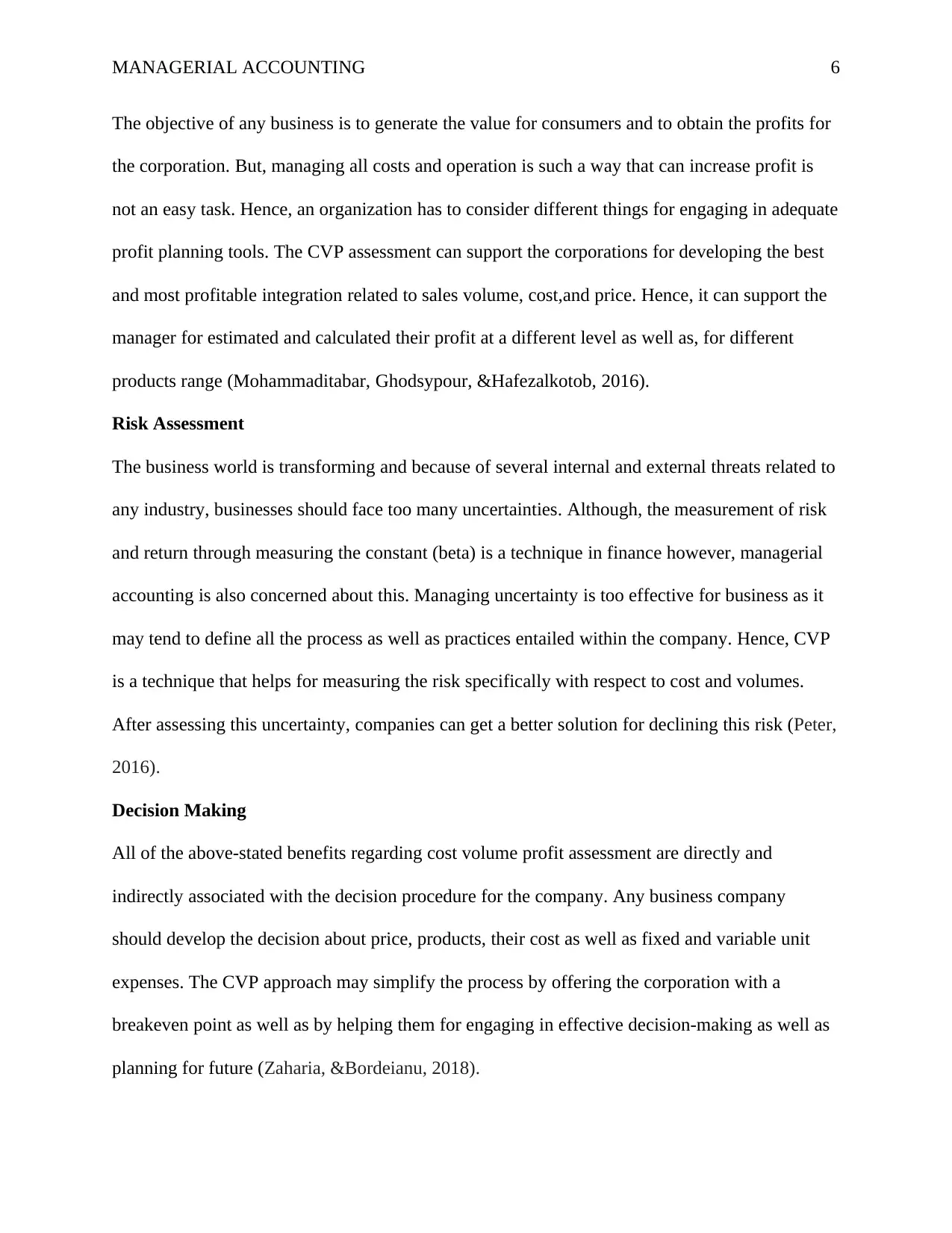
MANAGERIAL ACCOUNTING 6
The objective of any business is to generate the value for consumers and to obtain the profits for
the corporation. But, managing all costs and operation is such a way that can increase profit is
not an easy task. Hence, an organization has to consider different things for engaging in adequate
profit planning tools. The CVP assessment can support the corporations for developing the best
and most profitable integration related to sales volume, cost,and price. Hence, it can support the
manager for estimated and calculated their profit at a different level as well as, for different
products range (Mohammaditabar, Ghodsypour, &Hafezalkotob, 2016).
Risk Assessment
The business world is transforming and because of several internal and external threats related to
any industry, businesses should face too many uncertainties. Although, the measurement of risk
and return through measuring the constant (beta) is a technique in finance however, managerial
accounting is also concerned about this. Managing uncertainty is too effective for business as it
may tend to define all the process as well as practices entailed within the company. Hence, CVP
is a technique that helps for measuring the risk specifically with respect to cost and volumes.
After assessing this uncertainty, companies can get a better solution for declining this risk (Peter,
2016).
Decision Making
All of the above-stated benefits regarding cost volume profit assessment are directly and
indirectly associated with the decision procedure for the company. Any business company
should develop the decision about price, products, their cost as well as fixed and variable unit
expenses. The CVP approach may simplify the process by offering the corporation with a
breakeven point as well as by helping them for engaging in effective decision-making as well as
planning for future (Zaharia, &Bordeianu, 2018).
The objective of any business is to generate the value for consumers and to obtain the profits for
the corporation. But, managing all costs and operation is such a way that can increase profit is
not an easy task. Hence, an organization has to consider different things for engaging in adequate
profit planning tools. The CVP assessment can support the corporations for developing the best
and most profitable integration related to sales volume, cost,and price. Hence, it can support the
manager for estimated and calculated their profit at a different level as well as, for different
products range (Mohammaditabar, Ghodsypour, &Hafezalkotob, 2016).
Risk Assessment
The business world is transforming and because of several internal and external threats related to
any industry, businesses should face too many uncertainties. Although, the measurement of risk
and return through measuring the constant (beta) is a technique in finance however, managerial
accounting is also concerned about this. Managing uncertainty is too effective for business as it
may tend to define all the process as well as practices entailed within the company. Hence, CVP
is a technique that helps for measuring the risk specifically with respect to cost and volumes.
After assessing this uncertainty, companies can get a better solution for declining this risk (Peter,
2016).
Decision Making
All of the above-stated benefits regarding cost volume profit assessment are directly and
indirectly associated with the decision procedure for the company. Any business company
should develop the decision about price, products, their cost as well as fixed and variable unit
expenses. The CVP approach may simplify the process by offering the corporation with a
breakeven point as well as by helping them for engaging in effective decision-making as well as
planning for future (Zaharia, &Bordeianu, 2018).
⊘ This is a preview!⊘
Do you want full access?
Subscribe today to unlock all pages.

Trusted by 1+ million students worldwide
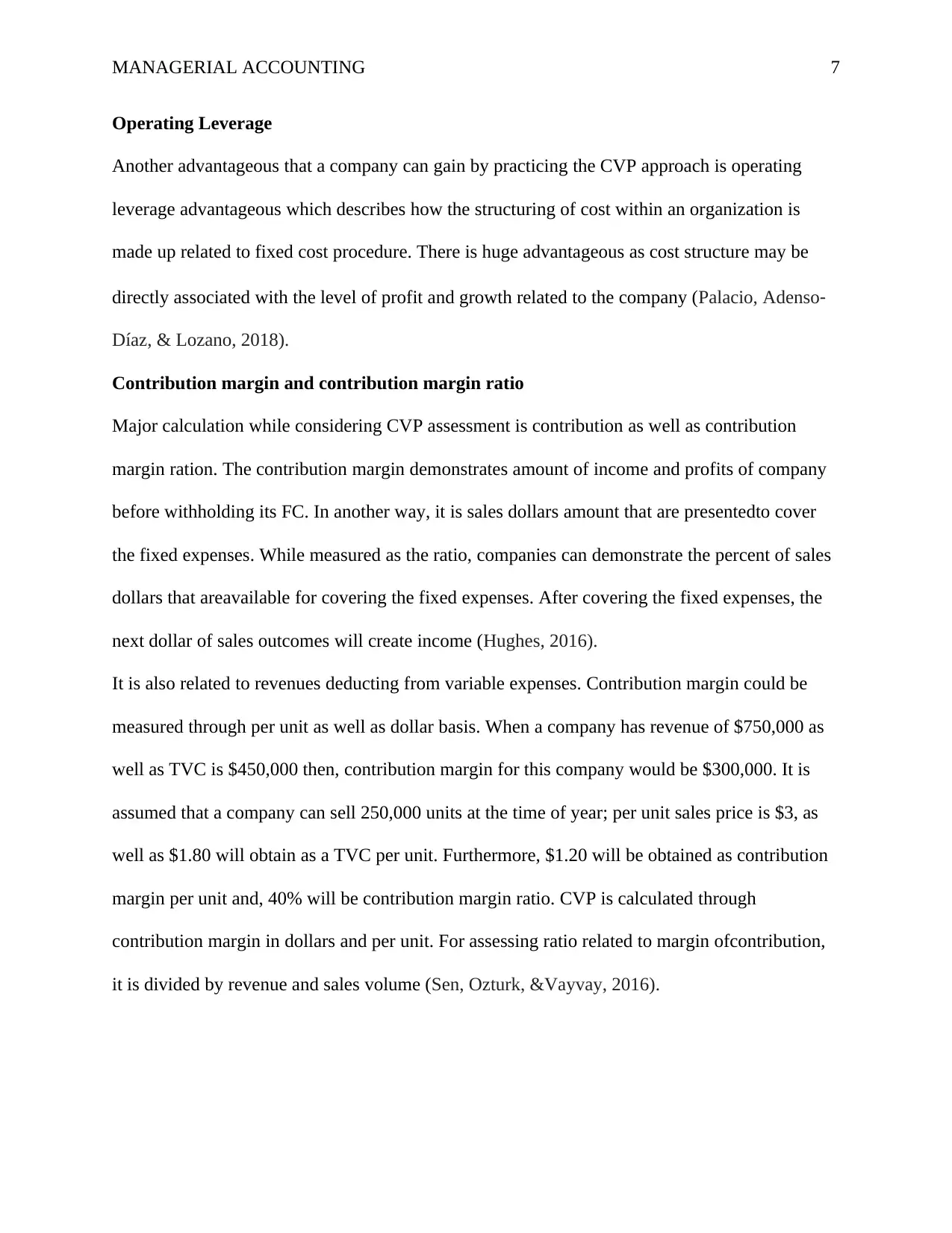
MANAGERIAL ACCOUNTING 7
Operating Leverage
Another advantageous that a company can gain by practicing the CVP approach is operating
leverage advantageous which describes how the structuring of cost within an organization is
made up related to fixed cost procedure. There is huge advantageous as cost structure may be
directly associated with the level of profit and growth related to the company (Palacio, Adenso‐
Díaz, & Lozano, 2018).
Contribution margin and contribution margin ratio
Major calculation while considering CVP assessment is contribution as well as contribution
margin ration. The contribution margin demonstrates amount of income and profits of company
before withholding its FC. In another way, it is sales dollars amount that are presentedto cover
the fixed expenses. While measured as the ratio, companies can demonstrate the percent of sales
dollars that areavailable for covering the fixed expenses. After covering the fixed expenses, the
next dollar of sales outcomes will create income (Hughes, 2016).
It is also related to revenues deducting from variable expenses. Contribution margin could be
measured through per unit as well as dollar basis. When a company has revenue of $750,000 as
well as TVC is $450,000 then, contribution margin for this company would be $300,000. It is
assumed that a company can sell 250,000 units at the time of year; per unit sales price is $3, as
well as $1.80 will obtain as a TVC per unit. Furthermore, $1.20 will be obtained as contribution
margin per unit and, 40% will be contribution margin ratio. CVP is calculated through
contribution margin in dollars and per unit. For assessing ratio related to margin ofcontribution,
it is divided by revenue and sales volume (Sen, Ozturk, &Vayvay, 2016).
Operating Leverage
Another advantageous that a company can gain by practicing the CVP approach is operating
leverage advantageous which describes how the structuring of cost within an organization is
made up related to fixed cost procedure. There is huge advantageous as cost structure may be
directly associated with the level of profit and growth related to the company (Palacio, Adenso‐
Díaz, & Lozano, 2018).
Contribution margin and contribution margin ratio
Major calculation while considering CVP assessment is contribution as well as contribution
margin ration. The contribution margin demonstrates amount of income and profits of company
before withholding its FC. In another way, it is sales dollars amount that are presentedto cover
the fixed expenses. While measured as the ratio, companies can demonstrate the percent of sales
dollars that areavailable for covering the fixed expenses. After covering the fixed expenses, the
next dollar of sales outcomes will create income (Hughes, 2016).
It is also related to revenues deducting from variable expenses. Contribution margin could be
measured through per unit as well as dollar basis. When a company has revenue of $750,000 as
well as TVC is $450,000 then, contribution margin for this company would be $300,000. It is
assumed that a company can sell 250,000 units at the time of year; per unit sales price is $3, as
well as $1.80 will obtain as a TVC per unit. Furthermore, $1.20 will be obtained as contribution
margin per unit and, 40% will be contribution margin ratio. CVP is calculated through
contribution margin in dollars and per unit. For assessing ratio related to margin ofcontribution,
it is divided by revenue and sales volume (Sen, Ozturk, &Vayvay, 2016).
Paraphrase This Document
Need a fresh take? Get an instant paraphrase of this document with our AI Paraphraser
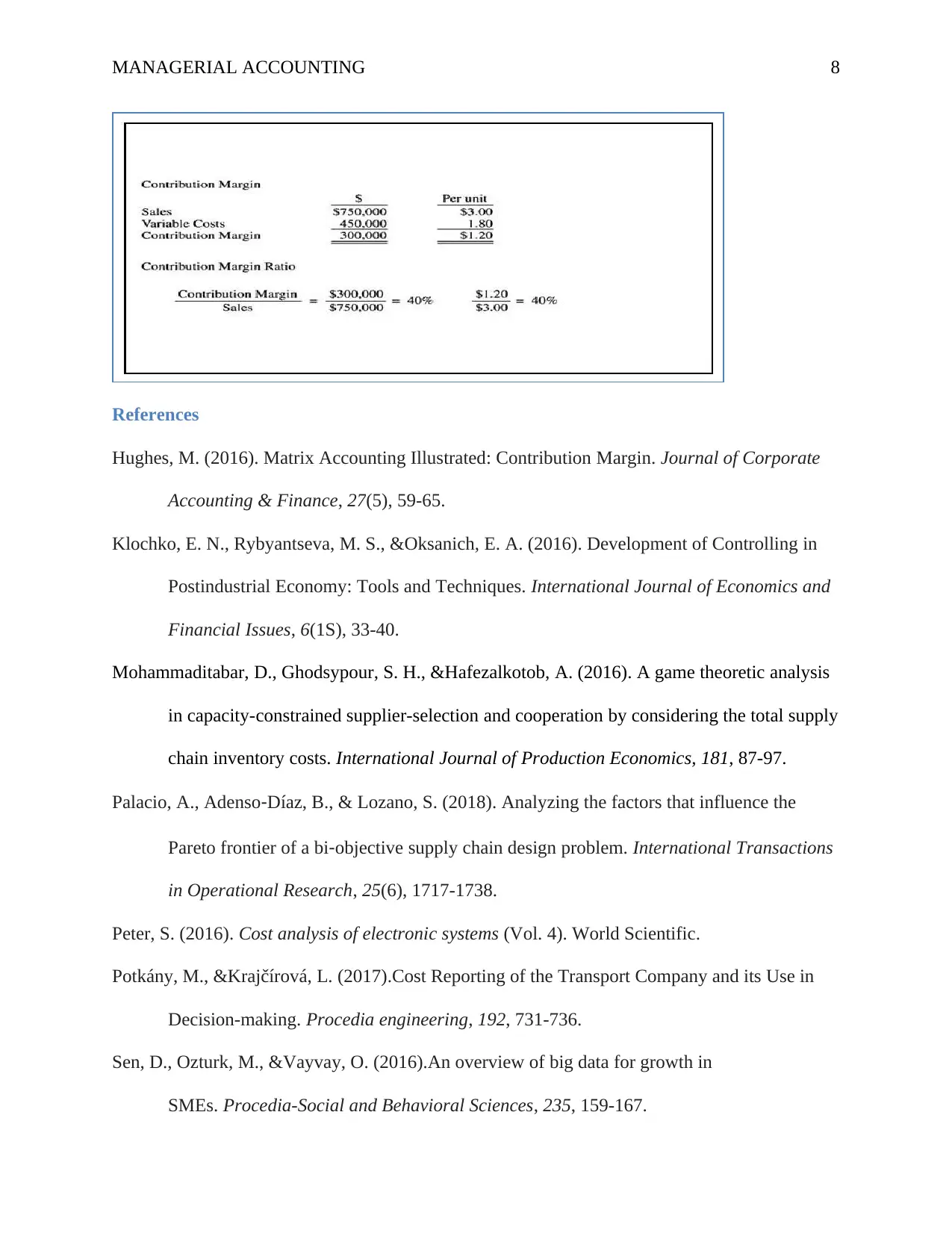
MANAGERIAL ACCOUNTING 8
References
Hughes, M. (2016). Matrix Accounting Illustrated: Contribution Margin. Journal of Corporate
Accounting & Finance, 27(5), 59-65.
Klochko, E. N., Rybyantseva, M. S., &Oksanich, E. A. (2016). Development of Controlling in
Postindustrial Economy: Tools and Techniques. International Journal of Economics and
Financial Issues, 6(1S), 33-40.
Mohammaditabar, D., Ghodsypour, S. H., &Hafezalkotob, A. (2016). A game theoretic analysis
in capacity-constrained supplier-selection and cooperation by considering the total supply
chain inventory costs. International Journal of Production Economics, 181, 87-97.
Palacio, A., Adenso‐Díaz, B., & Lozano, S. (2018). Analyzing the factors that influence the
Pareto frontier of a bi‐objective supply chain design problem. International Transactions
in Operational Research, 25(6), 1717-1738.
Peter, S. (2016). Cost analysis of electronic systems (Vol. 4). World Scientific.
Potkány, M., &Krajčírová, L. (2017).Cost Reporting of the Transport Company and its Use in
Decision-making. Procedia engineering, 192, 731-736.
Sen, D., Ozturk, M., &Vayvay, O. (2016).An overview of big data for growth in
SMEs. Procedia-Social and Behavioral Sciences, 235, 159-167.
References
Hughes, M. (2016). Matrix Accounting Illustrated: Contribution Margin. Journal of Corporate
Accounting & Finance, 27(5), 59-65.
Klochko, E. N., Rybyantseva, M. S., &Oksanich, E. A. (2016). Development of Controlling in
Postindustrial Economy: Tools and Techniques. International Journal of Economics and
Financial Issues, 6(1S), 33-40.
Mohammaditabar, D., Ghodsypour, S. H., &Hafezalkotob, A. (2016). A game theoretic analysis
in capacity-constrained supplier-selection and cooperation by considering the total supply
chain inventory costs. International Journal of Production Economics, 181, 87-97.
Palacio, A., Adenso‐Díaz, B., & Lozano, S. (2018). Analyzing the factors that influence the
Pareto frontier of a bi‐objective supply chain design problem. International Transactions
in Operational Research, 25(6), 1717-1738.
Peter, S. (2016). Cost analysis of electronic systems (Vol. 4). World Scientific.
Potkány, M., &Krajčírová, L. (2017).Cost Reporting of the Transport Company and its Use in
Decision-making. Procedia engineering, 192, 731-736.
Sen, D., Ozturk, M., &Vayvay, O. (2016).An overview of big data for growth in
SMEs. Procedia-Social and Behavioral Sciences, 235, 159-167.
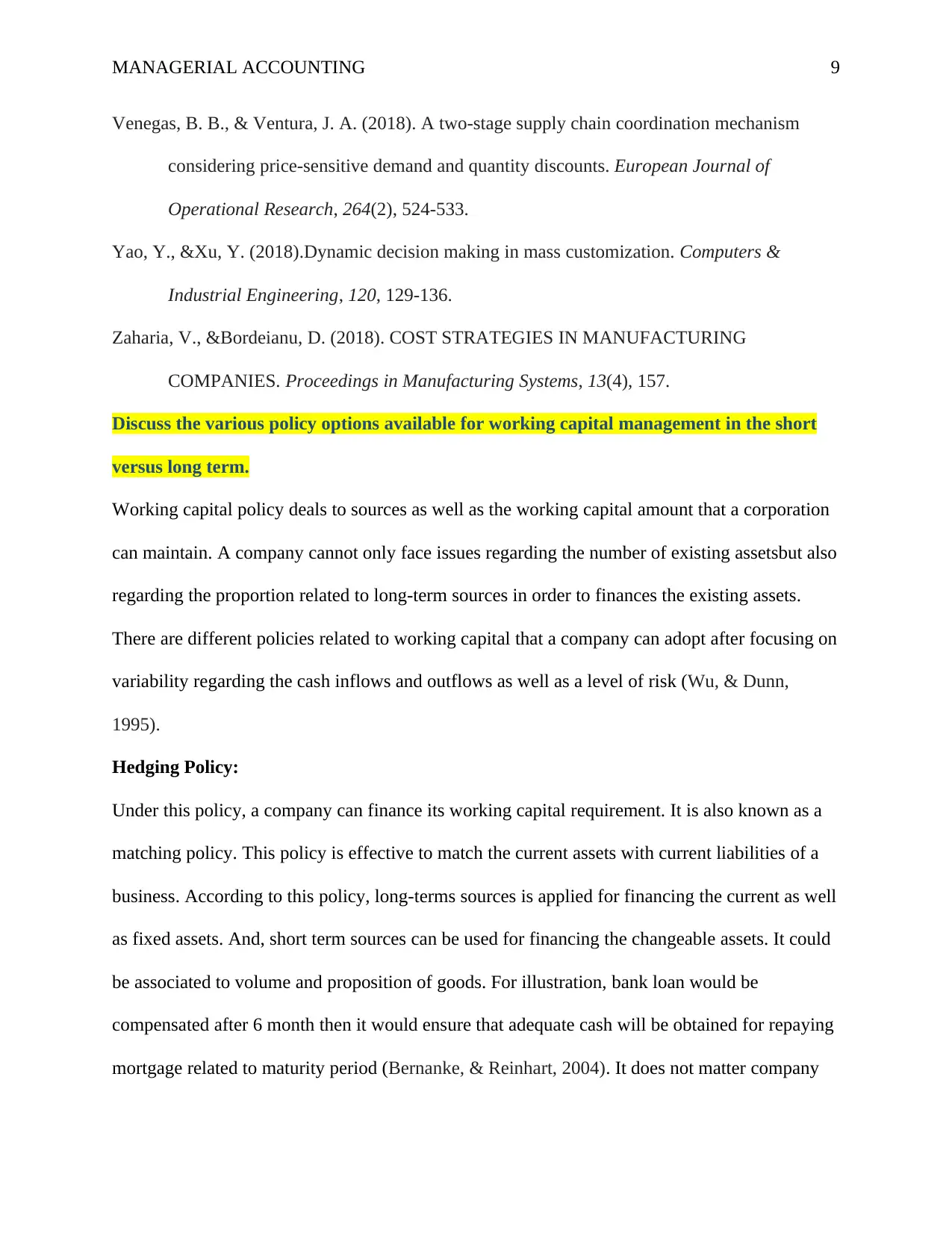
MANAGERIAL ACCOUNTING 9
Venegas, B. B., & Ventura, J. A. (2018). A two-stage supply chain coordination mechanism
considering price-sensitive demand and quantity discounts. European Journal of
Operational Research, 264(2), 524-533.
Yao, Y., &Xu, Y. (2018).Dynamic decision making in mass customization. Computers &
Industrial Engineering, 120, 129-136.
Zaharia, V., &Bordeianu, D. (2018). COST STRATEGIES IN MANUFACTURING
COMPANIES. Proceedings in Manufacturing Systems, 13(4), 157.
Discuss the various policy options available for working capital management in the short
versus long term.
Working capital policy deals to sources as well as the working capital amount that a corporation
can maintain. A company cannot only face issues regarding the number of existing assetsbut also
regarding the proportion related to long-term sources in order to finances the existing assets.
There are different policies related to working capital that a company can adopt after focusing on
variability regarding the cash inflows and outflows as well as a level of risk (Wu, & Dunn,
1995).
Hedging Policy:
Under this policy, a company can finance its working capital requirement. It is also known as a
matching policy. This policy is effective to match the current assets with current liabilities of a
business. According to this policy, long-terms sources is applied for financing the current as well
as fixed assets. And, short term sources can be used for financing the changeable assets. It could
be associated to volume and proposition of goods. For illustration, bank loan would be
compensated after 6 month then it would ensure that adequate cash will be obtained for repaying
mortgage related to maturity period (Bernanke, & Reinhart, 2004). It does not matter company
Venegas, B. B., & Ventura, J. A. (2018). A two-stage supply chain coordination mechanism
considering price-sensitive demand and quantity discounts. European Journal of
Operational Research, 264(2), 524-533.
Yao, Y., &Xu, Y. (2018).Dynamic decision making in mass customization. Computers &
Industrial Engineering, 120, 129-136.
Zaharia, V., &Bordeianu, D. (2018). COST STRATEGIES IN MANUFACTURING
COMPANIES. Proceedings in Manufacturing Systems, 13(4), 157.
Discuss the various policy options available for working capital management in the short
versus long term.
Working capital policy deals to sources as well as the working capital amount that a corporation
can maintain. A company cannot only face issues regarding the number of existing assetsbut also
regarding the proportion related to long-term sources in order to finances the existing assets.
There are different policies related to working capital that a company can adopt after focusing on
variability regarding the cash inflows and outflows as well as a level of risk (Wu, & Dunn,
1995).
Hedging Policy:
Under this policy, a company can finance its working capital requirement. It is also known as a
matching policy. This policy is effective to match the current assets with current liabilities of a
business. According to this policy, long-terms sources is applied for financing the current as well
as fixed assets. And, short term sources can be used for financing the changeable assets. It could
be associated to volume and proposition of goods. For illustration, bank loan would be
compensated after 6 month then it would ensure that adequate cash will be obtained for repaying
mortgage related to maturity period (Bernanke, & Reinhart, 2004). It does not matter company
⊘ This is a preview!⊘
Do you want full access?
Subscribe today to unlock all pages.

Trusted by 1+ million students worldwide
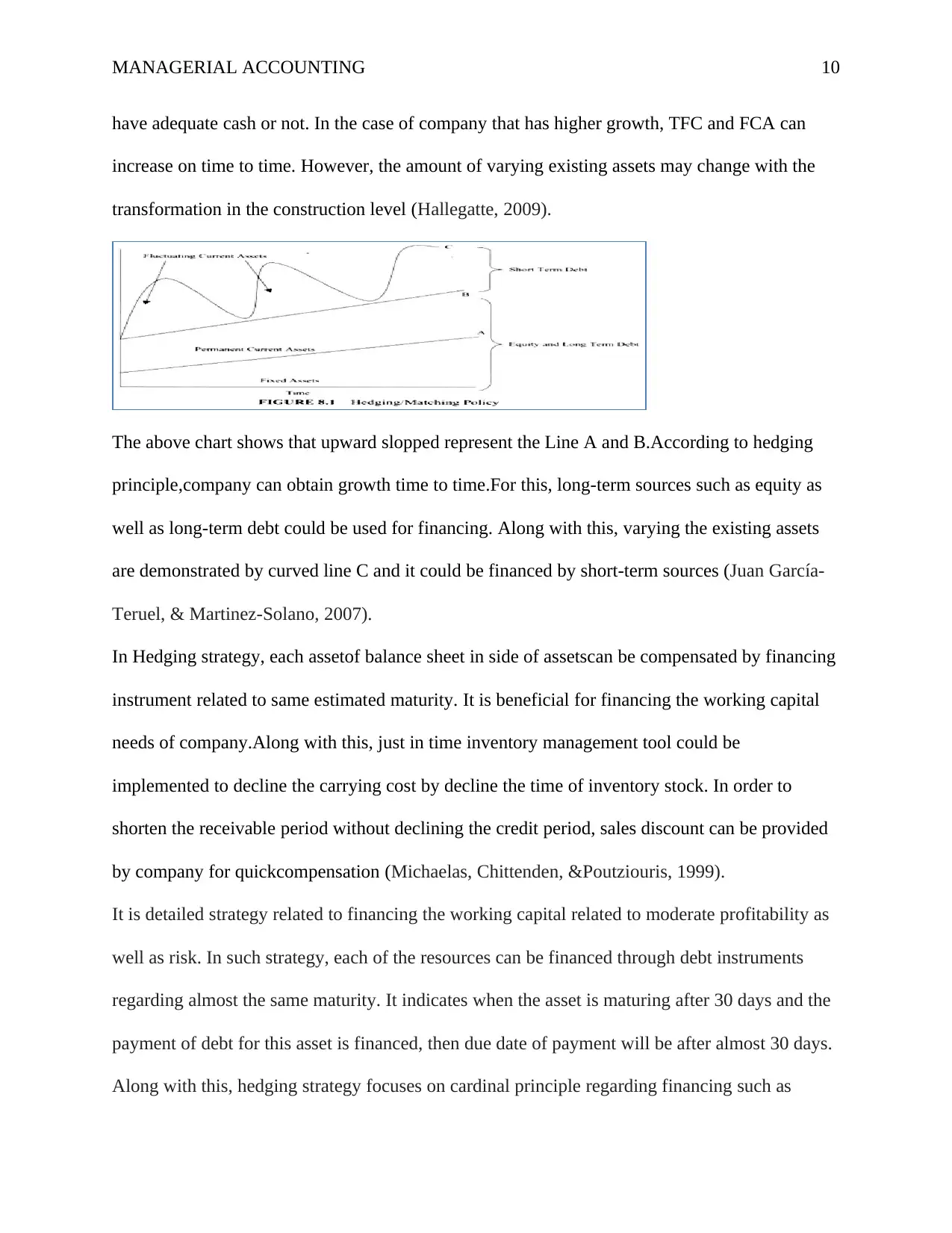
MANAGERIAL ACCOUNTING 10
have adequate cash or not. In the case of company that has higher growth, TFC and FCA can
increase on time to time. However, the amount of varying existing assets may change with the
transformation in the construction level (Hallegatte, 2009).
The above chart shows that upward slopped represent the Line A and B.According to hedging
principle,company can obtain growth time to time.For this, long-term sources such as equity as
well as long-term debt could be used for financing. Along with this, varying the existing assets
are demonstrated by curved line C and it could be financed by short-term sources (Juan García-
Teruel, & Martinez-Solano, 2007).
In Hedging strategy, each assetof balance sheet in side of assetscan be compensated by financing
instrument related to same estimated maturity. It is beneficial for financing the working capital
needs of company.Along with this, just in time inventory management tool could be
implemented to decline the carrying cost by decline the time of inventory stock. In order to
shorten the receivable period without declining the credit period, sales discount can be provided
by company for quickcompensation (Michaelas, Chittenden, &Poutziouris, 1999).
It is detailed strategy related to financing the working capital related to moderate profitability as
well as risk. In such strategy, each of the resources can be financed through debt instruments
regarding almost the same maturity. It indicates when the asset is maturing after 30 days and the
payment of debt for this asset is financed, then due date of payment will be after almost 30 days.
Along with this, hedging strategy focuses on cardinal principle regarding financing such as
have adequate cash or not. In the case of company that has higher growth, TFC and FCA can
increase on time to time. However, the amount of varying existing assets may change with the
transformation in the construction level (Hallegatte, 2009).
The above chart shows that upward slopped represent the Line A and B.According to hedging
principle,company can obtain growth time to time.For this, long-term sources such as equity as
well as long-term debt could be used for financing. Along with this, varying the existing assets
are demonstrated by curved line C and it could be financed by short-term sources (Juan García-
Teruel, & Martinez-Solano, 2007).
In Hedging strategy, each assetof balance sheet in side of assetscan be compensated by financing
instrument related to same estimated maturity. It is beneficial for financing the working capital
needs of company.Along with this, just in time inventory management tool could be
implemented to decline the carrying cost by decline the time of inventory stock. In order to
shorten the receivable period without declining the credit period, sales discount can be provided
by company for quickcompensation (Michaelas, Chittenden, &Poutziouris, 1999).
It is detailed strategy related to financing the working capital related to moderate profitability as
well as risk. In such strategy, each of the resources can be financed through debt instruments
regarding almost the same maturity. It indicates when the asset is maturing after 30 days and the
payment of debt for this asset is financed, then due date of payment will be after almost 30 days.
Along with this, hedging strategy focuses on cardinal principle regarding financing such as
Paraphrase This Document
Need a fresh take? Get an instant paraphrase of this document with our AI Paraphraser
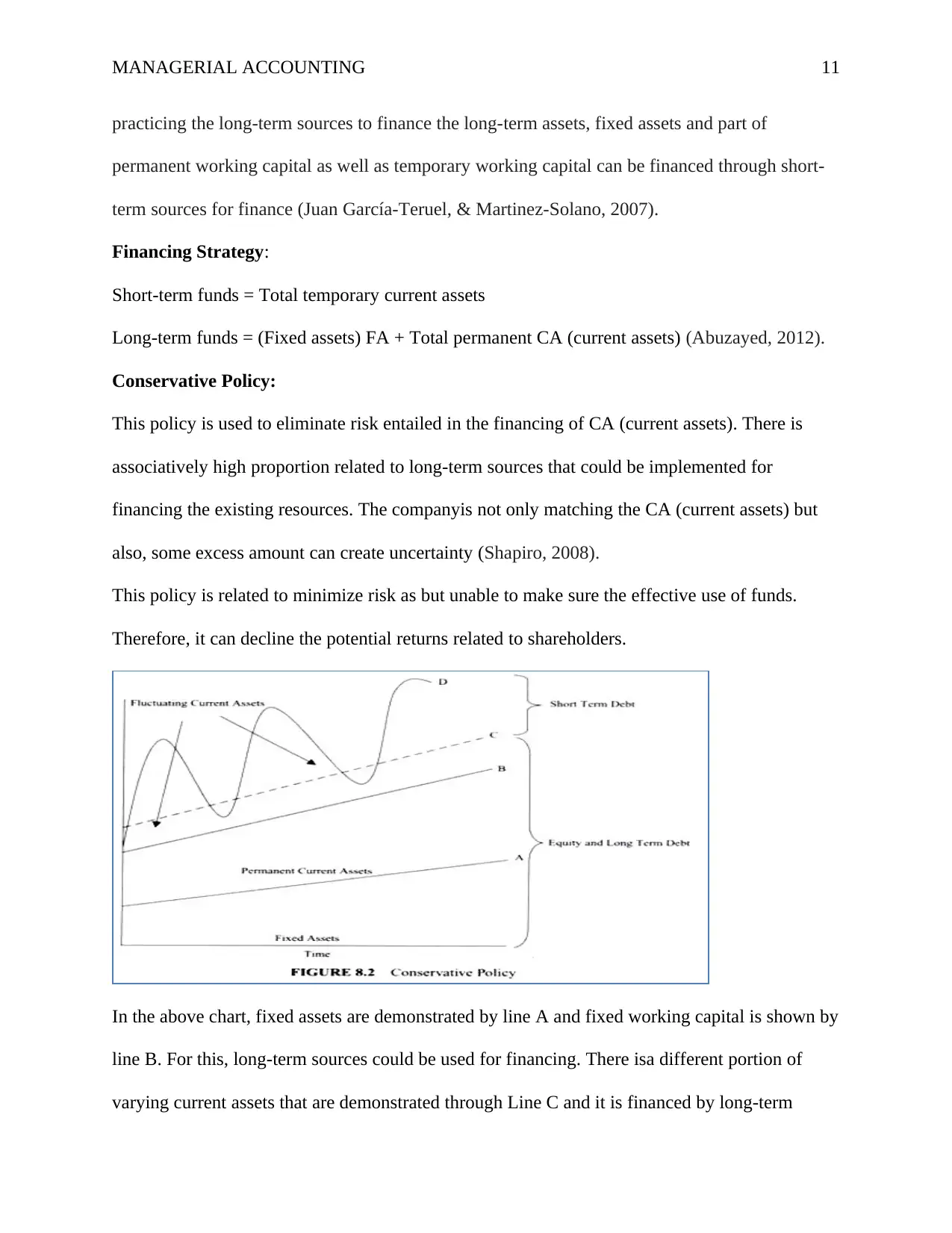
MANAGERIAL ACCOUNTING 11
practicing the long-term sources to finance the long-term assets, fixed assets and part of
permanent working capital as well as temporary working capital can be financed through short-
term sources for finance (Juan García-Teruel, & Martinez-Solano, 2007).
Financing Strategy:
Short-term funds = Total temporary current assets
Long-term funds = (Fixed assets) FA + Total permanent CA (current assets) (Abuzayed, 2012).
Conservative Policy:
This policy is used to eliminate risk entailed in the financing of CA (current assets). There is
associatively high proportion related to long-term sources that could be implemented for
financing the existing resources. The companyis not only matching the CA (current assets) but
also, some excess amount can create uncertainty (Shapiro, 2008).
This policy is related to minimize risk as but unable to make sure the effective use of funds.
Therefore, it can decline the potential returns related to shareholders.
In the above chart, fixed assets are demonstrated by line A and fixed working capital is shown by
line B. For this, long-term sources could be used for financing. There isa different portion of
varying current assets that are demonstrated through Line C and it is financed by long-term
practicing the long-term sources to finance the long-term assets, fixed assets and part of
permanent working capital as well as temporary working capital can be financed through short-
term sources for finance (Juan García-Teruel, & Martinez-Solano, 2007).
Financing Strategy:
Short-term funds = Total temporary current assets
Long-term funds = (Fixed assets) FA + Total permanent CA (current assets) (Abuzayed, 2012).
Conservative Policy:
This policy is used to eliminate risk entailed in the financing of CA (current assets). There is
associatively high proportion related to long-term sources that could be implemented for
financing the existing resources. The companyis not only matching the CA (current assets) but
also, some excess amount can create uncertainty (Shapiro, 2008).
This policy is related to minimize risk as but unable to make sure the effective use of funds.
Therefore, it can decline the potential returns related to shareholders.
In the above chart, fixed assets are demonstrated by line A and fixed working capital is shown by
line B. For this, long-term sources could be used for financing. There isa different portion of
varying current assets that are demonstrated through Line C and it is financed by long-term
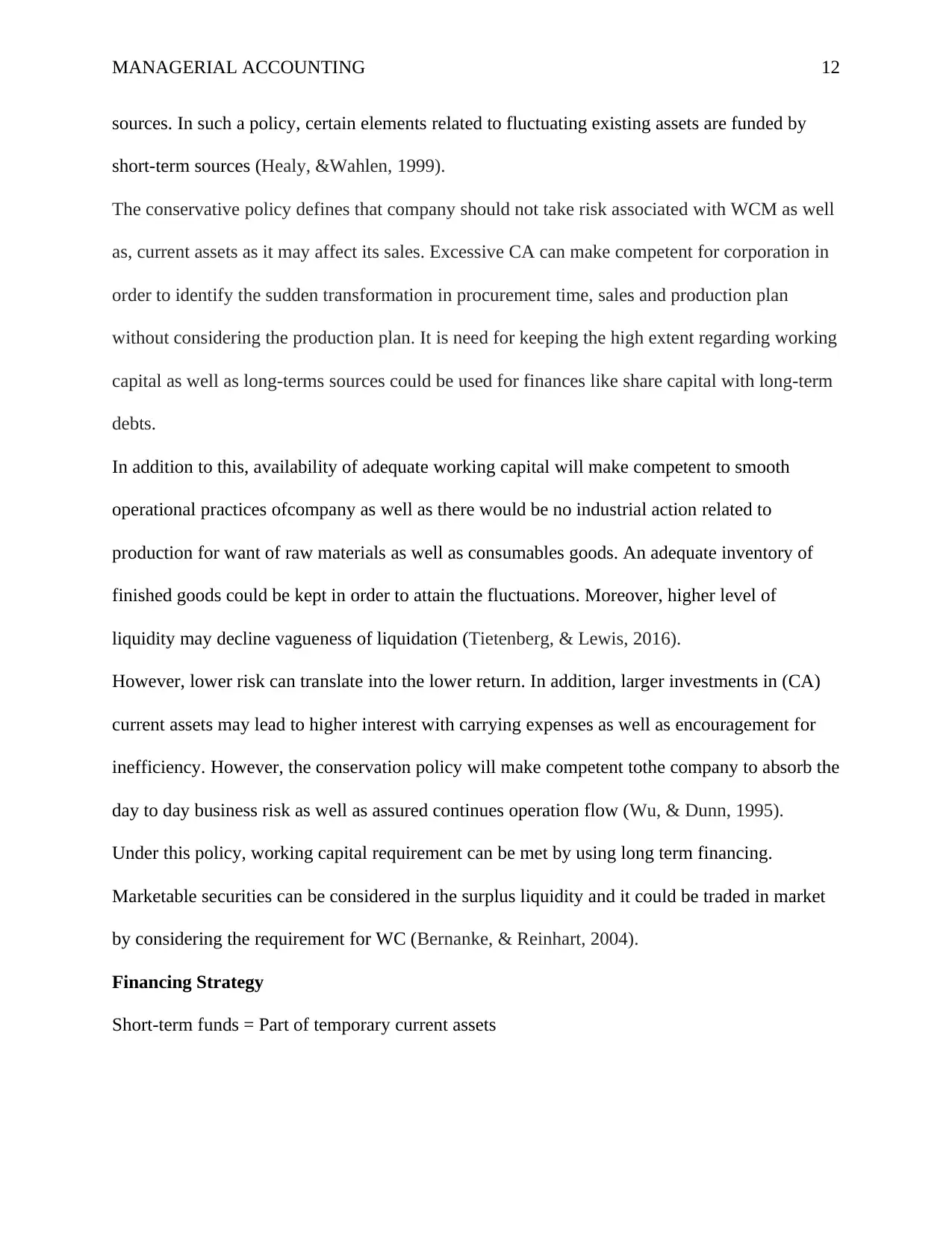
MANAGERIAL ACCOUNTING 12
sources. In such a policy, certain elements related to fluctuating existing assets are funded by
short-term sources (Healy, &Wahlen, 1999).
The conservative policy defines that company should not take risk associated with WCM as well
as, current assets as it may affect its sales. Excessive CA can make competent for corporation in
order to identify the sudden transformation in procurement time, sales and production plan
without considering the production plan. It is need for keeping the high extent regarding working
capital as well as long-terms sources could be used for finances like share capital with long-term
debts.
In addition to this, availability of adequate working capital will make competent to smooth
operational practices ofcompany as well as there would be no industrial action related to
production for want of raw materials as well as consumables goods. An adequate inventory of
finished goods could be kept in order to attain the fluctuations. Moreover, higher level of
liquidity may decline vagueness of liquidation (Tietenberg, & Lewis, 2016).
However, lower risk can translate into the lower return. In addition, larger investments in (CA)
current assets may lead to higher interest with carrying expenses as well as encouragement for
inefficiency. However, the conservation policy will make competent tothe company to absorb the
day to day business risk as well as assured continues operation flow (Wu, & Dunn, 1995).
Under this policy, working capital requirement can be met by using long term financing.
Marketable securities can be considered in the surplus liquidity and it could be traded in market
by considering the requirement for WC (Bernanke, & Reinhart, 2004).
Financing Strategy
Short-term funds = Part of temporary current assets
sources. In such a policy, certain elements related to fluctuating existing assets are funded by
short-term sources (Healy, &Wahlen, 1999).
The conservative policy defines that company should not take risk associated with WCM as well
as, current assets as it may affect its sales. Excessive CA can make competent for corporation in
order to identify the sudden transformation in procurement time, sales and production plan
without considering the production plan. It is need for keeping the high extent regarding working
capital as well as long-terms sources could be used for finances like share capital with long-term
debts.
In addition to this, availability of adequate working capital will make competent to smooth
operational practices ofcompany as well as there would be no industrial action related to
production for want of raw materials as well as consumables goods. An adequate inventory of
finished goods could be kept in order to attain the fluctuations. Moreover, higher level of
liquidity may decline vagueness of liquidation (Tietenberg, & Lewis, 2016).
However, lower risk can translate into the lower return. In addition, larger investments in (CA)
current assets may lead to higher interest with carrying expenses as well as encouragement for
inefficiency. However, the conservation policy will make competent tothe company to absorb the
day to day business risk as well as assured continues operation flow (Wu, & Dunn, 1995).
Under this policy, working capital requirement can be met by using long term financing.
Marketable securities can be considered in the surplus liquidity and it could be traded in market
by considering the requirement for WC (Bernanke, & Reinhart, 2004).
Financing Strategy
Short-term funds = Part of temporary current assets
⊘ This is a preview!⊘
Do you want full access?
Subscribe today to unlock all pages.

Trusted by 1+ million students worldwide
1 out of 34
Related Documents
Your All-in-One AI-Powered Toolkit for Academic Success.
+13062052269
info@desklib.com
Available 24*7 on WhatsApp / Email
![[object Object]](/_next/static/media/star-bottom.7253800d.svg)
Unlock your academic potential
Copyright © 2020–2025 A2Z Services. All Rights Reserved. Developed and managed by ZUCOL.





